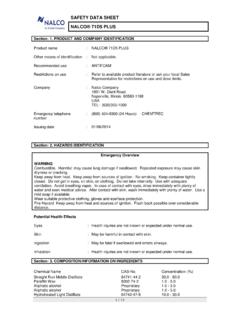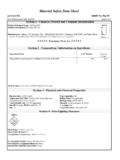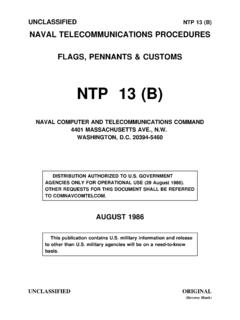Transcription of MATERIAL SAFETY DATA SHEET - …
1 MATERIAL SAFETY data SHEET . Prepared to OSHA, CMA, ANSI, Canadian WHMIS Standards, Australian WorkSafe, Japanese Industrial Standard JIS Z 7250:2000, and European Directives 1. PRODUCT IDENTIFICATION. TRADE NAME (AS LABELED): Windshield Washer Fluid, Winter Blend SYNONYMS: Product #2071. CHEMICAL SHIPPING NAME/CLASS: Flammable Liquids, (Methanol). NUMBER: UN 1993. MANUFACTURER'S NAME: Emerald Services, Inc. ADDRESS: 1825 Alexander Ave., Tacoma, WA 98421 USA. EMERGENCY PHONE: (800) 424-9300 (CHEMTREC - #7619). BUSINESS PHONE: (206) 832-3225. DATE OF PREPARATION: March 20, 2012. DATE OF REVISION: March 20, 2012. 2. HAZARD IDENTIFICATION. EMERGENCY OVERVIEW: Danger! Product Description: This product is a thin colorless liquid with a characteristic odor. Health Hazards: Can cause serious complications if swallowed. Can cause eye and skin irritation upon contact. Inhalation can cause irritation. Flammability Hazards: Flammable Liquid with flash point of 84 F. Reactivity Hazards: This product is not reactive.
2 Environmental Hazards: Release of the product may cause adverse effects to the aquatic environment. Emergency Recommendations: Emergency responders must have personal protective equipment and fire protection appropriate for the situation to which they are responding. EU LABELING AND CLASSIFICATION: This product meets the definition of a hazardous substance or preparation according to EU Regulations (EC) No 1272/2008. INDEX NUMBER: EC# 200-659-6 Annex 1 Index # 603-001-00-X. EC# 200-578-6 Annex 1 Index # 603-002-00-5. EC# 231-791-2 This substance is not classified in the Annex I of Directive 67/548/EEC. GHS CLASSIFICATIONS: Flammable Liquid Category 2 HAZARDOUS MATERIAL IDENTIFICATION SYSTEM FLAMMABILITY. Acute Inhalation Toxicity Category 3 (BLUE) 2. HEALTH HAZARD. Acute Dermal Toxicity Category 3. Acute Oral Toxicity Category 3 FLAMMABILITY HAZARD (RED) 3 3. STOT SE Category 1. REACTIVITY. HAZARD. (YELLOW) 0. HEALTH. 2 0 REACTIVITY. SIGNAL WORD : Danger PROTECTIVE EQUIPMENT.
3 -- EYES RESPIRATORY HANDS BODY. SEE SECTION 8 SEE SECTION 8. OTHER. For Routine Industrial Use and Handling Applications HAZARD STATEMENT: Scale: 0 = Minimal 1 = Slight 2 = Moderate 3 = Serious 4 = Severe * = Chronic hazard H225 Highly Flammable Liquid and Vapor H331 Toxic if inhaled H311 Toxic in contact with skin Emerald Services Inc. Page 1 of 6. MATERIAL SAFETY data SHEET . H301 Toxic if swallowed H370 Causes damage to organs PREVENTION STATEMENT : P210 Keep away from heat/sparks/open flames/hot surfaces. No Smoking P233 Keep container tightly closed. P240 Ground/bond container and receiving equipment. P260 Do not breathe dust/fume/gas/mist/vapors/spray. P264 Wash skin thouroughly after handling P280 Wear protective gloves/protective clothing/eye protection/face protection. P314 Get medical advice/attention if you feel unwell. P331 Do NOT induce vomiting. P301+P310 IF SWALLOWED: Immediately call a POISON CENTER or Doctor/Physician. RESPONSE STATEMENT: P363 Wash contaminated clothing before reuse.
4 P302 +P352 IF ON SKIN: Wash with plenty of soap and water. P333 + P313 IF skin irritation or rash occurs : Get medical advice/attention. HEALTH EFFECTS OR RISKS FROM EXPOSURE: ACUTE: INHALATION: High concentrations are irritating to the respiratory tract; may cause headache, dizziness, nausea, vomiting and malaise. SKIN: Contact may cause irritation. EYES: Contact may cause irritation and discomfort. INGESTION: May result in vomiting; aspiration of vomitus into the lungs must be avoided; DO NOT induce vomiting. Minute amounts aspirated into the lungs can produce severe lung injury, chemical pneumonitis, pulmonary edema or death. CHRONIC: Prolonged skin contact may cause moderate irritation or dermatitis. This product does not contain any ingredient designated by IARC, NTP, ACGIH or OSHA as probable or suspected human carcinogens. 3. COMPOSITION AND INFORMATION ON INGREDIENTS. Hazardous Ingredients: WT% CAS# EINECS # Hazard Classification Risk Phrases Methonal 15 - 35% 67-56-1 200-659-6 [F] Flammable, R11, R23/24/25, R39/23/24/25.
5 [T] Toxic Ethanol .1 15% 64-17-5 200-578-6 [F] Flammable R11. Water BALANCE 7732-18-5 231-791-2 None None Balance of other ingredients is less than 1% in concentration (or for carcinogens, reproductive None toxins, or respiratory sensitizers). NOTE: ALL WHMIS required information is included in appropriate sections based on the ANSI format. This product has been classified in accordance with the hazard criteria of the CPR and the MSDS contains all the information required by the CPR, EU Directives and the Japanese Industrial Standard JIS Z 7250: 2000. 4. FIRST-AID MEASURES. SKIN EXPOSURE: If this product contaminates the skin, begin decontamination with running water and soap. Remove exposed or contaminated clothing, taking care not to contaminate eyes. The contaminated individual should seek medical attention if any adverse effect occurs. EYE EXPOSURE: If this product enter the eyes, open contaminated individual's eyes while under gently running water. Use sufficient force to open eyelids.
6 Remove contact lenses if worn. Have contaminated individual "roll" eyes. Minimum flushing is for 15 minutes. Contaminated individual must seek medical attention if irritation develops or persists or if visual changes occur. INHALATION: If vapors/mists generated by this product are inhaled, remove contaminated individual to fresh air. If necessary, use artificial respiration to support vital functions. SEEK IMMEDIATE MEDICAL ATTENTION. INGESTION: If this product is swallowed, CALL PHYSICIAN OR POISON CONTROL CENTER FOR MOST CURRENT. INFORMATION. DO NOT induce vomiting; if vomiting occurs spontaneously, keep head below hips to prevent aspiration of liquid into lungs. Never induce vomiting or give diluents (milk or water) to someone who is unconscious, having convulsions, or unable to swallow. SEEK IMMEDIATE MEDICAL ATTENTION. Emerald Services Inc. Page 2 of 6. MATERIAL SAFETY data SHEET . MEDICAL CONDITIONS AGGRAVATED BY EXPOSURE: Individuals with pre-existing skin and respiratory conditions may be more susceptible to effects of this MATERIAL .
7 RECOMMENDATIONS TO PHYSICIANS: Treat symptoms and eliminate overexposure. 5. FIRE-FIGHTING MEASURES. FLASH POINT: 84 F. AUTOIGNITION TEMPERATURE: Not Established FLAMMABLE LIMITS (in air by volume, %): Lower Not Established Upper Not Established FIRE EXTINGUISHING MATERIALS: Use fire extinguishing methods listed below: Water Spray: Yes Carbon Dioxide: Yes Foam: Yes Dry Chemical: Yes Halon: Yes Other: Any C Class UNUSUAL FIRE AND EXPLOSION HAZARDS: Vapors are heavier than air and may travel along the ground. This could cause ignition from a distant source. Explosion Sensitivity to Mechanical Impact: No Explosion Sensitivity to Static Discharge: No SPECIAL FIRE-FIGHTING PROCEDURES: Incipient fire responders should wear eye protection. Structural firefighters must wear Self-Contained Breathing Apparatus and full protective equipment. Isolate materials not yet involved in the fire and protect personnel. Move containers from fire area if this can be done without risk; otherwise, cool with carefully applied water spray.
8 If possible, prevent runoff water from entering storm drains, bodies of water, or other environmentally sensitive areas. 6. ACCIDENTAL RELEASE MEASURES. SPILL AND LEAK RESPONSE: Evacuate unprotected personnel from the area. Maintain adequate ventilation. Follow personal protective equipment recommendations found in section 8. Contain and recover liquid if possible. Use non- sparking tools and equipment. Cover or absorb spilled liquid with sand, earth or other inert MATERIAL . Clean up spill immediately and place in appropriate containers. Do not discharge to sewers and surface waters. Notify authorities if entry occurs. Remove all sources of ignition. Regulations (CERCLA) requires reporting spills and releases to soil, water and air in excess of reportable quantities. The toll free number for the US Coast Guard National Response Center is (800) 424-8802. Dispose of in accordance with Federal, State, and local hazardous waste disposal regulations and those of Canada and its Provinces, those of Australia, Japan and EU Member States (see Section 13, Disposal Considerations).
9 7. HANDLING and STORAGE. WORK PRACTICES AND HYGIENE PRACTICES: As with all chemicals, avoid getting this product ON YOU or IN YOU. Wash thoroughly after handling this product. Do not eat, drink, smoke, or apply cosmetics while handling this product. Avoid breathing vapors/mists generated by this product. Use in a well-ventilated location. Remove contaminated clothing immediately. STORAGE AND HANDLING PRACTICES: Protect against physical damage. Store in a cool, dry well-ventilated location away from heat or ignition sources. Keep out of direct sunlight. Keep containers tightly closed. Containers of this MATERIAL may be hazardous when empty since they retain residues. Observe all warnings and precautions listed for the product. 8. EXPOSURE CONTROLS - PERSONAL PROTECTION. Chemical Name CAS# ACGIH TLV OSHA TWA. Methonal 67-56-1 200 ppm 200 ppm Ethanol 64-17-5 1000 ppm 1000 ppm Water 7732-18-5 Not Listed Not Listed VENTILATION AND ENGINEERING CONTROLS: Use with adequate ventilation to ensure exposure levels are maintained below the limits provided below.
10 Use a chemical fume hood or local exhaust ventilation, and process enclosure if necessary, to control exposure. Ensure eyewash/ SAFETY shower stations are available near areas where this product is used. Emerald Services Inc. Page 3 of 6. MATERIAL SAFETY data SHEET . The following information on appropriate Personal Protective Equipment is provided to assist employers in complying with OSHA regulations found in 29 CFR Subpart I (beginning at ) or equivalent standard of Canada, or standards of EU member states (including EN 149 for respiratory PPE, and EN 166 for face/eye protection), and those of Japan. Please reference applicable regulations and standards for relevant details. RESPIRATORY PROTECTION: Maintain concentrations below guidelines listed above, if applicable. If necessary, use only respiratory protection authorized in the Federal OSHA Respiratory Protection Standard (29 CFR ), equivalent State standards, Canadian CSA Standard , the European Standard EN149, or EU member states.






